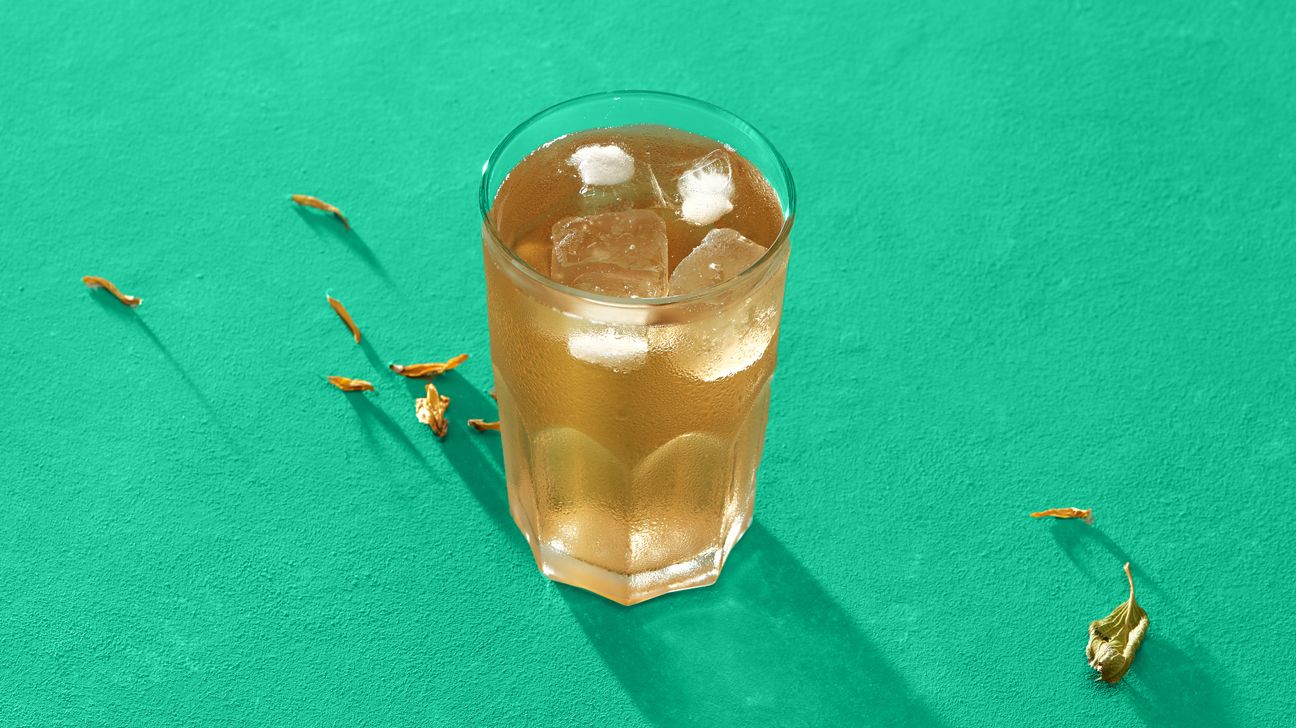Forget sparkling water — iced tea is my summer drink of choice. It’s super simple to make, there’s no mysterious “natural flavoring,” and you can customize each batch for a personalized wellness kick.
Whether you’re craving better sleep, a mellow mood, or more energy to make the most of summer’s long days, there’s an herb (and often more than one) that can give you the desired effect.
Here are five iced teas to try for a refreshing summer boost loaded with herbal benefits.
Tulsi, or holy basil, is an adaptogenic herb, which means its health benefits are vast.
“It has a slightly earthier flavor profile than regular basil, with hints of clove and cinnamon,” says Rachel Miller, an herbalist and nutritionist and the owner of Zhi Herbals.
While tulsi is a multitasking wellness herb, Miller often recommends holy basil tea for an energy boost and mood support.
Tulsi’s adaptogenic properties can help you tackle an overloaded to-do list, preventing burnout and exhaustion in a healthier way than a caffeine infusion drip you joke about needing.
The underlying stressors won’t magically disappear, but with help from tulsi, your body won’t react by releasing cortisol. You’ll get it all done with less stress and anxiety.
“Holy basil can be found fresh at some specialty grocery stores, farmers markets, or grown easily from seed in similar conditions where you would grow common basil,” Miller notes.
Tulsi tea recipe:
- If you’re lucky enough to find fresh tulsi, use this technique.
- If using dried tulsi, steep 1- 1 1/2 tablespoons of dried tulsi in 4 cups of hot water for 5 minutes, then chill.
Hibiscus tea can make you think of the tropics. The colorful flower, also known as roselle, is grown throughout Mexico, South America, and Africa. It’s indeed one of the best summer drinks to keep you cool.
Herbalist Steph Zabel notes that hibiscus may help regulate body temperature in the summer, delivering a naturally cooling effect. The herb’s tart qualities also make it refreshing and hydrating.
Hibiscus tea recipe:
- Steep 1/4 cup of hibiscus flowers in 4 cups of hot water for 5–10 minutes.
- Optional: Add zest of 1 lime or lemon to complement the tart flavors.
- Sweeten if desired, using your favorite sweetener.
Apple mint is another popular refresher for the dog days of summer.
“It’s naturally sweet and a nice break from the usual vibes of peppermint or spearmint,” says Lydia Willoughby, owner of Sassafras Mercantile, a metaphysical boutique that sells farm-to-cup herbs.
Willoughby keeps apple mint iced tea on tap at her shop. “I love apple mint as iced tea to chill and enjoy while sipping in the shade,” she says.
The herb is loaded with good-for-you vitamins and minerals, including vitamin A, vitamin C, potassium, and iron. It also contains some analgesic and anti-inflammatory properties.
When made from fresh mint rather than dried, mint teas have a sharp, clean taste that’ll keep you coming back for more. Given mint’s aggressive growth habits, mints like apple mint make great windowsill herbs. Pot up a plant (look for this at the farmers market in spring or grow your own from seed) and snip fresh mint for the absolute freshest of teas.
Fresh apple mint tea recipe:
- Coarsely chop 1/4 cup of apple mint leaves.
- Steep mint in 4 cups of hot water for 5–10 minutes, then chill.
Sure, rose tea looks pretty and has a gentle, loving connotation perfect for your self-care game. But it’s also loaded with antioxidants.
“It contains polyphenols that are thought to reduce the risk of certain types of cancer, heart disease, and type 2 diabetes, as well as protect your brain from degenerative disease,” explains Lisa Li, herbal tea expert and founder of The Qi, which sells flower teas from small family farms.
Li continues to sing rose tea’s praises by pointing out its adaptogenic properties to promote better gut health and more restful sleep.
If you’re making your own rose tea, be careful. While all varieties of roses are technically edible, those grown for floral uses may have been treated with chemicals. Li recommends looking for organically grown roses that are cultivated specifically for tea or food-grade consumption.
Rose tea recipe:
- If using fresh roses, separate rose petals from the base of the flower, which can add bitterness to rose tea. Steep 2 cups of fresh rose petals in 4 cups of hot water for 5 minutes, then chill.
- If using dried roses, steep 1/4 cup of dried roses in 4 cups of hot water for 5 minutes, then chill.
Acupuncturist and Chinese medicine expert Tsao-Lin E. Moy, owner of Integrative Healing Arts, likes using mugwort to promote deeper sleep.
There hasn’t been much research on humans to back that up definitively, but some research on mice suggests that one species of mugwort could have sleep-inducing effects.
“In Chinese medicine [mugwort] is called Ai Ye and helps to bring blood flow to the uterus,” Moy explains. “Try mugwort if you struggle to fall back asleep after waking in the night or if troubling dreams keep you from resting.”
Mugwort has a bit of a savory note that some people might find bitter. To make the flavor a bit sweeter, mix dried mugwort with lavender. Lavender is another sleep ally with a floral, somewhat peppery note best enjoyed in small doses.
Warning: If you use too much, the tea can taste perfumy.
Mugwort tea recipe:
- Steep 1 ounce of dried mugwort in 4 cups of hot water for 5–10 minutes.
- Optional: Combine 1/2 ounce of mugwort with 3 tablespoons of lavender buds and steep for 5–10 minutes.
- Chill and drink as desired.
Sip away, and happy relaxing!
Lindsey Danis is a Hudson Valley-based writer who covers food, travel, and LGBTQ stories. Follow her on Instagram and Twitter.


